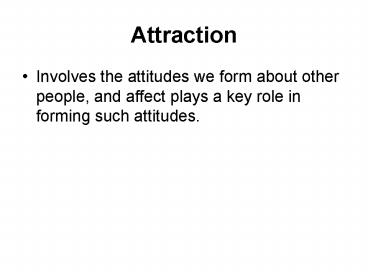Attraction - PowerPoint PPT Presentation
1 / 29
Title:
Attraction
Description:
One person's evaluation of someone else along a dimension that ... Clothing, grooming, age, eyeglasses, etc. Behavioral differences. Inconsistent information ... – PowerPoint PPT presentation
Number of Views:23
Avg rating:3.0/5.0
Title: Attraction
1
Attraction
- Involves the attitudes we form about other
people, and affect plays a key role in forming
such attitudes.
2
Interpersonal Attraction
- One persons evaluation of someone else along a
dimension that ranges from strong liking to
strong disliking.
3
Differences in Attraction
- Based on
- 1. The person making the evaluation
- 2. The similarities and differences between the
evaluator and the person being evaluated - 3. The situational context
4
Repeated Unplanned Contacts Leading to Attraction
- Proximity In attraction research, the closeness
between two individuals residences, classroom
seats, work areas, and so on. - Repeated Exposure Frequent contact with a
stimulus. - Exceptions to the Repeated Exposure Effect.
5
Effects of Proximity
- Residential Proximity
- Other possibilities
- Research supports
6
Affective States as the Basis for Attraction
- Two most important characteristics of affect
- Affect not a continuum
- Research
- Two ways in which affect can influence attraction
7
Direct Effects of Affective State
- Less obvious direct effects
- Group presentation
8
Indirect Effects of Affective States
- Classical conditioning explanation
- Taking it a step further
- Stigma A personal characteristic that at least
some other individuals perceive negatively. - Affect and interpersonal behavior
9
How Vulnerable are we to Affective Manipulations
- Election time example
- Are we helpless in the face of affective
manipulations? - Informed vs uninformed
10
Affiliation Need
- Need for affiliation Tendency to establish
interpersonal relationships. - As a trait (individual difference)
- Situation
- High vs. Low
11
Individual Differences in the Need to Affiliate
- Two ways to measure
- explicit motivation
- implicit motivation
- high on explicit Vs implicit
- Reasons for affiliating Four basic motives Hill
(1987)
12
Situational Determinants of the Need to Affiliate
- Stressful situations, why?
- Schachter (1959)
- Social comparison the tendency to seek out other
people-even strangers-in order to communicate
what is going on, to compare perceptions, and to
make decisions about what to do. - Cognitive clarity
13
Responding to Observable Characteristics
- Liking/disliking someone at first sight
- Physical attractiveness
14
Physical Attractiveness
- The combination of facial and bodily
characteristics that are evaluated as beautiful
or handsome at the most attractive extreme of the
dimension and unattractive at the other extreme
of the dimension. - Basically the facial and bodily characteristics
that people in a give culture regard as visually
appealing (or unappealing).
15
Physical Attractiveness
- Physical attractiveness and interpersonal
evaluations - Gender differences
- Why does physical appearance lead to attraction?
- Evolutionary
- Gender differences
16
Physical Attractiveness
- Stereotypes
- Are they accurate?
- Different ages
- Personal estimations of attractiveness
- Appearance anxiety
- Negative attributes associated with good looks.
17
Appearance Anxiety
- Apprehension or worry about whether ones
physical appearance is adequate and about the way
ones appearance is evaluated by other people.
18
What do we mean by attractive?
- Two approaches
19
Weight and Attractiveness
- Sheldon, Stevens, Tucker (1940)
- Endomorphs
- Mesomorphs
- Ectomorphs
- Prejudices against obesity
20
Other Aspects of Appearance that Influence
Attraction
- Just plain, the way you look
- Clothing, grooming, age, eyeglasses, etc.
- Behavioral differences
- Inconsistent information
- What a person eats
- First names.
21
What happens next? As the odds of a Relationship
Increase
- 1. Both people in a positive emotional state
- 2. Both people motivated by affiliation needs
- 3. Both people evaluates the overall
characteristics of the other in a positive way - 4. Discovering areas of similarity
- 5. They feel an express positive evaluations of
one another.
22
Is Attraction Influenced by Similarity,
Dissimilarity, or Both?
- Similarity-yes
- Proportion of similar attitudes
- Does the similarity-attraction relationship
generalize? - Rosenbaum (1986) repulsion hypothesis
23
Proportion of Similar Attitudes
- The number of topics on which two individuals
hold the same views divided by the total number
of topics on which they compare their views can
be expressed as a percentage (or ratio). - The higher the percentage of similar attitudes,
the greater the liking.
24
Repulsion Hypothesis
- Rosenbaum (1986)
- Attraction is not enhanced by similar attitudes
but only decreased by dissimilar attitudes.
25
Why do Similar and Dissimilar Attitudes Influence
Attraction?
- Balance theory Specifies the relationships
among - an individuals liking for another person
- his or her attitude about a given topic
- the other persons perceived attitude about the
same topic.
26
Balance, Imbalance, Nonbalance
- Balance when two people like each other and
agree about some topic. - Imbalance Two people like each other but
disagree about something - Nonbalance Two people dislike each other.
- What Balance theory doesnt explain.
- Festingers social comparison theory
27
Festingers Social Comparison Theory
- Consensual Validation The perceived validation
of ones views that is provided when someone else
expresses identical views.
28
Matching Hypothesis
- The proposal that individuals are attracted to
one another as a friend, romantic partners or
spouses on the basis of similar
attributes-physical attractiveness age race
personality characteristics or social assets
such as wealth, education, or power.
29
Reciprocal Positive Evaluations
- If you like me, I like you
- Flattery































